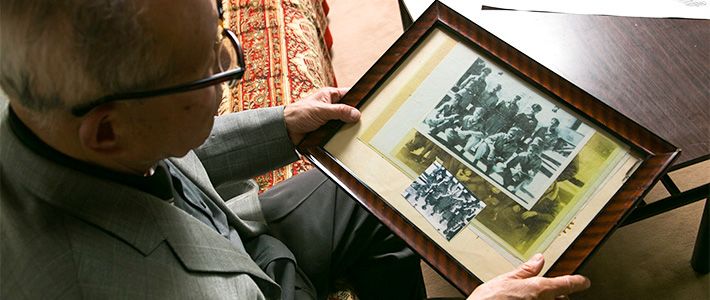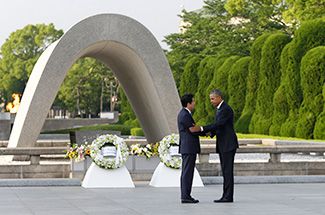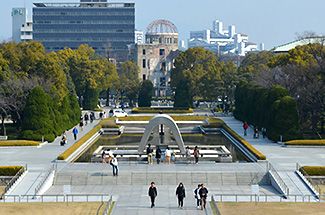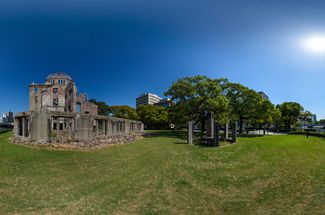
The Japanese Historian Honoring Hiroshima’s American Dead
Politics Society Culture- English
- 日本語
- 简体字
- 繁體字
- Français
- Español
- العربية
- Русский
A Passion for Unraveling a Mystery
For more than four decades, Mori Shigeaki pieced together the fates of a dozen US airmen who perished alongside tens of thousands of Japanese when the atomic bomb detonated above Hiroshima in 1945, struggling to overcome official inertia and quiet criticism of his motivation.
Himself a survivor of the first nuclear weapon used in war, the 79-year-old Mori saw his painstaking work go largely unremarked until, by chance, it came to the attention of an American filmmaker living just outside Boston, whose great uncle was a schoolboy friend of one of the 12 fliers.
Barry Frechette says he knew the story of Mori’s search for the truth would make a compelling documentary, but he had no idea just how fundamentally the project would change the lives of all of those involved.
“Mr. Mori has had a forty-year passion to unravel this mystery and, for him, it’s all in the tiny details,” Frechette said. “He wanted to pay his respects to these twelve airmen, for them to be remembered and for their families to know what happened. And that’s what he has achieved.”
 Mori Shigeaki speaks in his Hiroshima home. (© Kusano Seiichirō)
Mori Shigeaki speaks in his Hiroshima home. (© Kusano Seiichirō)
Downed at the End of the War
The circumstances that brought the two men together started long before Frechette was born, when the crews of two US Army Air Forces B-24 Liberator bombers—the Lonesome Lady and the Taloa—and two US Navy dive bombers were shot down as they attacked targets in Japan in late July 1945.
Not all the men survived being downed. Most of those who did were transported to Hiroshima, the largest nearby city, and held as prisoners of war in the Chūgoku Military Police Headquarters. First Lieutenant Thomas Cartwright, the pilot of the Lonesome Lady, was separated from his colleagues and sent to Tokyo to be interrogated.
 A photo of Thomas Cartwright, pilot of the Lonesome Lady. (© Kusano Seiichirō)
A photo of Thomas Cartwright, pilot of the Lonesome Lady. (© Kusano Seiichirō)
That stroke of good fortune was to save Cartwright’s life, as the police headquarters was less than 400 meters from the epicenter when Little Boy exploded shortly after 8:15 am of August 6, 1945.
Nine of the men are believed to have died instantly. Sergeant Hugh Atkinson of Seattle miraculously survived the initial blast but died shortly afterwards of radiation poisoning. Two other prisoners, Army Staff Sergeant Ralph Neal and Navy Airman 3rd Class Normand Brissette, had earlier been taken to another location in the city to be questioned and were farther away when the bomb detonated about 600 meters above the city.
Nevertheless, the two men were too close to the blast. Despite being treated by a Japanese doctor, they died within a couple of days from exposure to radiation.
Three days later, on August 9, a second atomic bomb was dropped on Nagasaki; on August 15, Japan surrendered.
 The Hiroshima Atomic Bomb Dome lies near the epicenter of the August 6 blast. (© Kusano Seiichirō)
The Hiroshima Atomic Bomb Dome lies near the epicenter of the August 6 blast. (© Kusano Seiichirō)
Chaos of the World’s First Atomic Attack
In the chaotic days immediately before and after the surrender, the US military did not know what had become of its prisoners held in Hiroshima. All the authorities could do was to inform their families that they were missing. That response remained the official line long after the relatives had given up hope of their safe return. It was not until 1983 that Washington reluctantly confirmed that US prisoners had died in the atomic bombing.
Mori, who was 8 at the time of the attack, also came very close to dying in the cauldron that engulfed his hometown.
“I was about 2.5 kilometers from the center of the blast, on a hill near my school to the northwest,” he recalls. “The blast threw me into a stream and then I found myself inside the mushroom cloud. It was so dark that when I held my hands up about 10 centimeters in front of my face, I couldn’t see them.
“The blast was unbelievable. I saw things around me being lifted up into the air by its power,” he says. “I thought the Earth itself had exploded.
“It was a miracle that I was not injured.”
Like the rest of the survivors, Mori set about rebuilding his life after the war was over, excelling in history studies at school. His desire to become a history professor was frustrated, however, and after graduating from university he worked in a leading securities company and then for a musical instrument maker, Yamaha Corp.
The Amateur Historian Finds His Mission
He never lost his passion for research and the past, however. In the 1970s he stumbled across the story of an American bomber that had crashed near the mountain village of Ikachi (currently part of the city of Yanai, Yamaguchi Prefecture) in the closing days of the conflict.
“I went to the crash site and spoke to the farmers working in the mountains there, asking if they knew anything,” he says. “All the villagers knew the story. They were able to take me to the exact site of the crash.”
The aircraft, Mori eventually discovered, was the Lonesome Lady. Additional research over a number of years enabled him to identify her crew and to confirm that they had been taken by the police to Hiroshima. Here, he learned, they were joined by the crews of three other aircraft that had been shot down.
 Mori holds a piece of wreckage from the B-24 Taloa. (© Kusano Seiichirō)
Mori holds a piece of wreckage from the B-24 Taloa. (© Kusano Seiichirō)
But knowing the men’s names was not sufficient for Mori; he wanted to reach out to their surviving relatives to share his information. With little official assistance forthcoming—the Japanese government wanted to put the war behind it and the US authorities were keen to portray a former enemy as a firm ally—Mori started looking for family names that matched those of the dead crew members. He started with the state of Washington, calling the local operators there and asking to be connected to people with the names on his list.
“There were so many memorials in Hiroshima to the people who died in the bombing, but not a single one to the American POWs who had been killed,” he says. “I survived, but that just made me all the more determined to look for the families of the dead men in order to let them know about their loved ones.
“I made up my mind that before I died, I would keep searching until I found the families and had the names of the American airmen placed on the official register of the victims of the bomb [at the Peace Memorial Hall],” Mori says. “But it wasn’t easy; there are fifty states in the United States and hundreds of millions of people.”
Making Connections with the Families of the Dead
Mori’s international phone bill climbed to ¥70,000 a month as he pursued his search, but he eventually found Francis Ryan, the brother of James Ryan, in Atlanta.
“The first time I was able to register one of their names, I cried so hard,” recalls Mori. “Nobody had asked me to do this. No one helped me and they didn’t think I’d be able to do it, but I was determined to do whatever it took.”
Armed with new information provided by Francis Ryan—including new photos of the crew before a mission—Mori was quickly able to locate Cartwright, sparking a 20-year friendship that involved the exchange of more than 100 letters and cards until the former pilot’s death last year.
In 1999, Mori finally got his wish for a memorial to the US aircrew with the unveiling of a brass plaque on the site of the police headquarters. On the anniversary of the bombing in August 2012, Clifton Truman Daniel, the grandson of US President Harry Truman, who ordered the attack, met with Mori and visited the plaque to lay some flowers and pay his respects.
 The brass plaque for the US POWs who died in Hiroshima in 1945. (© Kusano Seiichirō)
The brass plaque for the US POWs who died in Hiroshima in 1945. (© Kusano Seiichirō)
Gradually, Mori’s perseverance paid off as he trawled through a vast trove of paperwork—including around 10,000 boxes of evidence in the US Library of Congress—that enabled him to trace the relatives of all 12 men.
Having solved this mystery, Mori is in no mood to halt his research. He has now turned his attention to determining the fates of British and Dutch POWs who were in Nagasaki when the second atomic bomb was dropped.
Mori’s Dedication Fascinates a Filmmaker
Members of one of the families, that of Normand Brissette, expressed gratitude to Mori for providing them with information on his fate. They also shared it with Eddie Chandonnet, his best friend from school. Chandonnet, in turn, told his grandnephew, Barry Frechette, that the family finally had information as to what had happened more than 60 years previously.
Frechette admits he was “immediately hooked on the story.”
“This was the tale of twelve Americans who had died in Hiroshima, but there was very little information about them—and that was just strange to me,” he says. “It was a story that I couldn’t let go of.”
Frechette began communicating with Mori in the spring of 2013 and flew to Japan for the first time in February 2014 to “see if the story was real.”
“I went to Mr. Mori’s home, and when I walked into his living room, there were piles of documents about each of the airmen, laid out on the piano and the coffee table,” he said. “He knew so much about each of them—whether they were married and had children, where they were from, the planes they had been on—and I knew straight away that somebody had to tell this story.
 Barry Frechette with Mori Shigeaki and his wife, Kayoko, during a trip to Japan. (Courtesy of Barry Frechette)
Barry Frechette with Mori Shigeaki and his wife, Kayoko, during a trip to Japan. (Courtesy of Barry Frechette)
“I didn’t expect to find a man in Japan who knew more about Normand Brissette than the people who drive past his monument in Lowell [Massachusetts] and don’t think twice about it,” he says. “But that’s just what I found.”
Frechette worked on the documentary over the following two years, coming to Japan with Susan Brissette Archinski, the niece of Normand Brissettte, and Ralph Neal, the nephew of the airman who was named after his late uncle.
The meetings were, inevitably, emotional and became a key element of Paper Lanterns, Frechette’s 60-minute documentary that pieces together the tales of the airmen, their surviving family members, and the Japanese historian who united them all.
“It has been a difficult three years to see the project through, but it has been so worth it,” says Frechette. “We have built up an incredible family and the world feels a lot smaller after doing this. To me, it’s important that Mr. Mori is recognized for all his hard work.
“He’s a very good man.”
The trailer for Paper Lanterns
US Prisoners of War Killed in the Atomic Bombing of Hiroshima
| Name | Hometown | Aircraft |
|---|---|---|
| Hugh H. Atkinson | Seattle, WA | Lonesome Lady |
| Charles O. Baumgartner | Sebring, OH | Taloa |
| Normand R. Brissette | Lowell, MA | Curtiss SB2C Helldiver |
| Joseph E. Dubinsky | Washington, PA | Taloa |
| Buford J. Ellison | Abilene, TX | Lonesome Lady |
| John J. Hantschel | Appleton, WI | Grumman F6F Hellcat |
| John A. Long Jr. | New Castle, PA | Lonesome Lady |
| Durden W. Looper | Huntington, AR | Lonesome Lady |
| Julius Molnar | Kalamazoo, MI | Taloa |
| Ralph J. Neal | Corbin, KY | Lonesome Lady |
| Raymond L. Porter | Butler, PA | Curtiss SB2C Helldiver |
| James M. Ryan | Binghamton, NY | Lonesome Lady |
(Originally published in English on May 20, 2016. Based on interviews held on May 13 with Barry Frechette by video conference and May 14 with Mori Shigeaki in Hiroshima. Banner photo: Mori Shigeaki holds an old photo of the US airmen in his living room. © Kusano Seiichirō.)
▼Further reading
 Barack Obama’s Historic Hiroshima Visit Barack Obama’s Historic Hiroshima Visit |
 Hiroshima Peace Memorial Park Hiroshima Peace Memorial Park |
 World Heritage: Hiroshima Peace Memorial (Genbaku Dome) (360° Panorama) World Heritage: Hiroshima Peace Memorial (Genbaku Dome) (360° Panorama) |
history World War II film Hiroshima hibakusha POWs Mori Shigeaki

